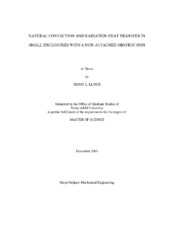| dc.description.abstract | Numerical simulations were used to investigate natural convection and radiation interactions in small enclosures of both two and three-dimensional geometries. The objectives of the research were to (1) determine the relative importance of natural convection and radiation, and to (2) estimate the natural convection heat transfer coefficients. Models are generated using Gambit, while numerical computations were conducted using the CFD code FLUENT. Dimensions for the two-dimensional enclosure were a height of 2.54 cm (1 inch), and a width that varied between 5.08 cm and 10.16 cm (2 inches and 4 inches). The three-dimensional model had a depth of 5.08 cm (2 inches) with the same height and widths as the two-dimensional model. The obstruction is located at the centroid of the enclosure and is represented as a circle in the two-dimensional geometry and a cylinder in the three-dimensional geometry. Obstruction diameters varied between .51 cm and 1.52 cm (0.2 inches and 0.6 inches).
Model parameters used in the investigation were average surface temperatures, net total heat flux, and net radiation heat flux. These parameters were used to define percent temperature differences, percent heat flux contributions, convective heat transfer coefficients, Nusselt numbers, and Rayleigh numbers. The Rayleigh numbers varied between 0.005 and 300, and the convective heat transfer coefficients ranged between 2 and 25 W/m2K depending on the point in the simulation. The simulations were conducted with temperatures ranging between 310 K and 1275 K on the right boundary. For right boundary temperatures above 800 K, the estimated error on the obstruction temperature is less than 6.1% for neglecting natural convection and conduction from the heat transfer analysis. Lower right boundary temperatures such as 310 K had significant contributions, over 50%, from heat transfer modes other than radiation. For lower right boundary temperatures, a means of including natural convection should be included. When a bulk fluid temperature and average surface temperature values are available, a time average heat transfer coefficient of 6.73 W/m2K is proposed for simplifying the numerical calculations. In the transient right boundary temperature analysis, all modes of heat transfer other than radiation can be neglected to have an error below 8.1%. | en |


